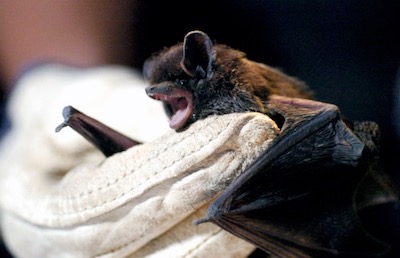866-295-4143, fbns@wayoflife.org

It is transmitted through the saliva of infected animals, primarily through biting and scratching. It attacks the central nervous system and is the most deadly virus. Most human infections come from stray dogs, cats, and bats.
The name rabies means “rage.” It was the name given by the Romans, from the Latin rabere (rage). The Greeks called it lyssa, which also means rage.
In infected animals, rabies takes two forms. “In the ‘furious’ form, wild animals may appear to be agitated, bite or snap at imaginary and real objects and drool excessively. In the ‘dumb’ form, wild animals may appear tame and seem to have no fear of humans. There are other signs, such as the animal appearing drunk or excessively wobbly, circling, seeming partially paralyzed, acting disorientated or mutilating itself. However, most of these signs can also be indicative of other diseases like distemper or lead poisoning. There are few behavioral signs that are telltale of rabies alone” (“Understanding Rabies,” The Humane Society of the United States).
The final three hours of a rabies victim is described as follows: “Challa Babu jolts ferociously from side to side, thrashing his head against a flimsy hospital bed as rabies consumes him. His eyes are wide, white spittle clings to the sides of his mouth and he bellows, pleadingly, between growls forced through clenched teeth. After an agonising three hours the 16-year-old is dead” (“Rabies Is Killing More Than 55,000,” The Independent, Sep. 25, 2011).
Rabies is almost always fatal without vaccination.
Onset symptoms include tingling at the site of exposure, restlessness, fever, chills, headache, fatigue, nausea, vomiting, constriction of the throat, numbness in extremities, followed by uncontrolled excitement, confusion, difficulty swallowing, followed by hallucinations, insomnia, excessive salivation, fear of water, partial paralysis of parts of the body, confusion, aggression, hyperactivity, brain hemorrhage, loss of consciousness, and death.
“The symptoms are like something from a horror film. Intense fear of air and water, throat surging into racking spasms at the sight of liquid and the gentlest of draughts feeling like a bomb blast, coupled with a frenzied energy and frothing at the mouth” (“Rabies Is Killing More Than 55,000,” The Independent, Sep. 25, 2011). “The hydrophobia is brought on by the extreme pain of swallowing liquids, not just water.”
The symptoms of massive salivation and aggression (biting) are part of the virus’s life cycle as a means of finding a new host. After the virus has attacked the host’s cells and replicated itself, it moves to the brain and activates mad aggression and extreme pain in swallowing liquids, in addition to other symptoms, finally moving to the salivary glands. The profuse amount of infected saliva is not swallowed due to the pain of swallowing. Thus, it is available to be introduced to a new host. The virus activates a biting/scratching aggression in order to transmit itself into another victim. This is what causes the mad dog scenario.
Before vaccination, rabies was always a death sentence, and hundreds of thousands died annually of this terrible disease.
The first rabies vaccine was developed in 1885 by Louis Pasteur. In July of that year, the vaccine was administered to nine-year-old Joseph Meister who had been bitten 14 times by a rabid dog. His mother had heard of Pasteur’s work and frantically traveled all day and night by train from Alsace in eastern France to Paris to locate him. The vaccine had never been tested on humans, but Pasteur was moved by the mother’s pleas. “For three weeks Pasteur watched anxiously at the boy’s bedside. To his overwhelming joy, the boy recovered” (“This Is What Happened to the First Person to Get the Rabies Vaccine,” Time, July 6, 2015). Joseph became a janitor at the Pasteur Institute.
In December, four boys in Newark, New Jersey, were bitten by a dog suspected of being rabid. They were Austin Fitzgerald, William Lane, Eddie Ryan, and Patrick Reynolds. A national campaign was launched to send them to France for treatment, and within days $1,000 was raised. They traveled on the steamship Canada to Paris and were successfully treated. They “returned home as ‘heroes,’ even taking a subsequent tour of American cities” (“Surviving Rabies 100 Years Ago,” National Museum of American History, Oct. 28, 2012).
In the 1920s, the dosage was reduced to 21 injections. The vaccine had to be delivered into the stomach muscle.
As of 2020, the rabies vaccine consists of a series of four shots to the hip or upper arm and is “100 percent effective in preventing rabies.” Two-dose and single dose vaccines are in clinical trials.
The vaccine can be administered after exposure during the incubation period (which varies from three weeks to three months). Once the symptoms appear, it is generally too late, because it has spread to the brain.
If one is bitten or scratched by an animal that is suspected to be rabid, he should immediately wash the wound aggressively with soap, preferably antiseptic soap such as betadine or Nolvasan, flushing the wound thoroughly with water. This can reduce risk of death. Then seek treatment.
In 2018, Ryker Roque, a six-year-old boy in Florida, died of rabies after being scratched by a bat. His father had found the bat and put it in a bucket on the porch and instructed Ryker, “Don’t touch it under any circumstance.” He ignored the warning and the bat scratched him. His parents decided not to seek medical attention after Ryker cried at the thought of getting shots. A week later, he complained of headache and numb fingers, and though the doctors tried their best to save him, he died
The widespread vaccination of pets and effective post-exposure treatment has dramatically reduced the numbers of rabies infections in developed countries. In America, there are only one or two cases a year. There is also widespread vaccination of wildlife by federal and state officials, using vaccine-laden baits.
Worldwide, 55,000 people still die of rabies annually, mostly due to stray dogs. The Indian subcontinent has the highest number of fatalities. In 2011, Kevin Shumaker, stationed in Afghanistan with the U.S. Army, was bitten by a rabid dog and received only three of the six shots, because the final half of the treatment had expired. He was flown to the States and given aggressive treatment, but he died. In 2017, an American woman traveling in India was bitten by a rabid puppy. After she returned to the States, she began experiencing pain and tingling in her right arm. Eighteen days later she was dead (“Woman suffers Terrifying Death from Rabies,” American Council on Science and Health, Jan. 4, 2019).
Since 2008, rabies has spread rapidly in the island nation of Bali after being introduced by a stray dog on a trade ship. Since then more than 130 deaths have occurred and hundreds of visitors “have cut short their trips after attacks.”
- Receive these reports by email
- www.wayoflife.org
______________________
Sharing Policy: Much of our material is available for free, such as the hundreds of articles at the Way of Life web site. Other items we sell to help fund our expensive literature and foreign church planting ministries. Way of Life's content falls into two categories: sharable and non-sharable. Things that we encourage you to share include the audio sermons, O Timothy magazine, FBIS articles, and the free eVideos and free eBooks. You are welcome to make copies of these at your own expense and share them with friends and family. You may also post parts of reports and/or entire reports to websites, blogs, etc as long as you give proper credit (citation). A link to the original report is very much appreciated as the reports are frequently updated and/or expanded. Things we do not want copied and distributed are "Store" items like the Fundamental Baptist Digital Library, print editions of our books, electronic editions of the books that we sell, the videos that we sell, etc. The items have taken years to produce at enormous expense in time and money, and we use the income from sales to help fund the ministry. We trust that your Christian honesty will preserve the integrity of this policy. "For the scripture saith, Thou shalt not muzzle the ox that treadeth out the corn. And, The labourer is worthy of his reward" (1 Timothy 5:18). Questions? support@wayoflife.org
Goal:Distributed by Way of Life Literature Inc., the Fundamental Baptist Information Service is an e-mail posting for Bible-believing Christians. Established in 1974, Way of Life Literature is a fundamental Baptist preaching and publishing ministry based in Bethel Baptist Church, London, Ontario, of which Wilbert Unger is the founding Pastor. Brother Cloud lives in South Asia where he has been a church planting missionary since 1979. Our primary goal with the FBIS is to provide material to assist preachers in the edification and protection of the churches.
Offering: Offerings are welcome if you care to make one. If you have been helped and/or blessed by our material offerings can be mailed or made online with with Visa, Mastercard, Discover, or Paypal. For information see: www.wayoflife.org/about/makeanoffering.html.





